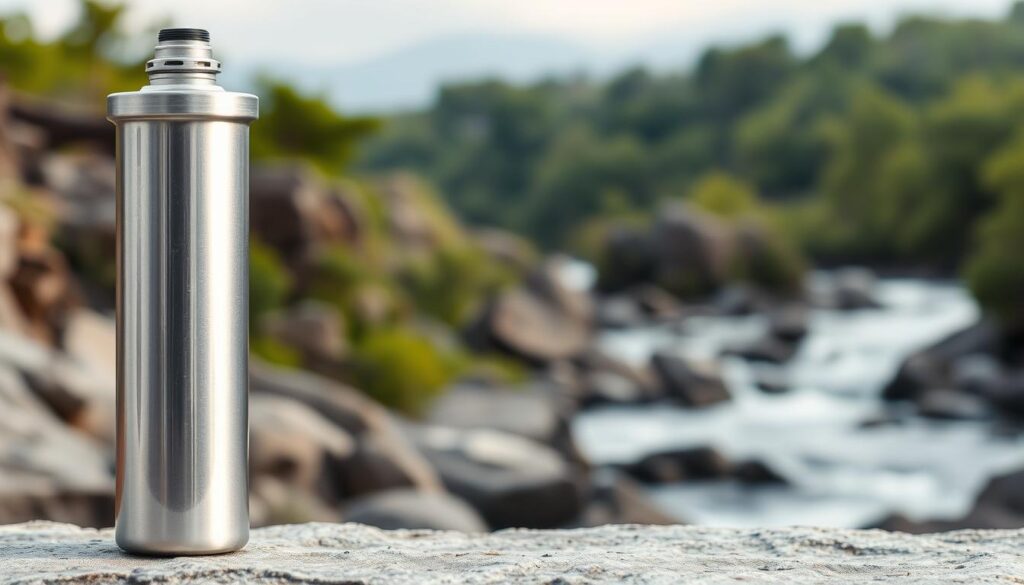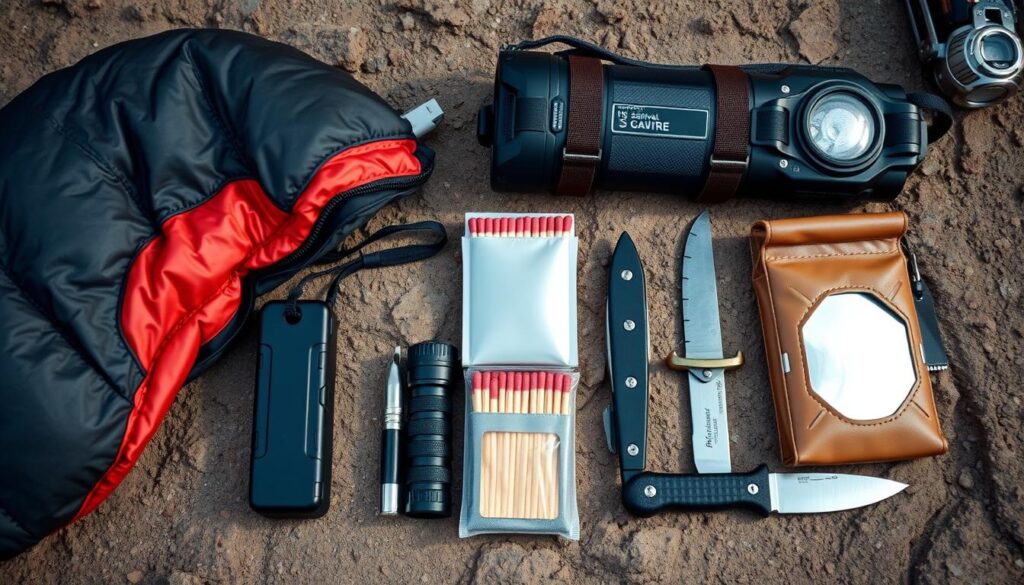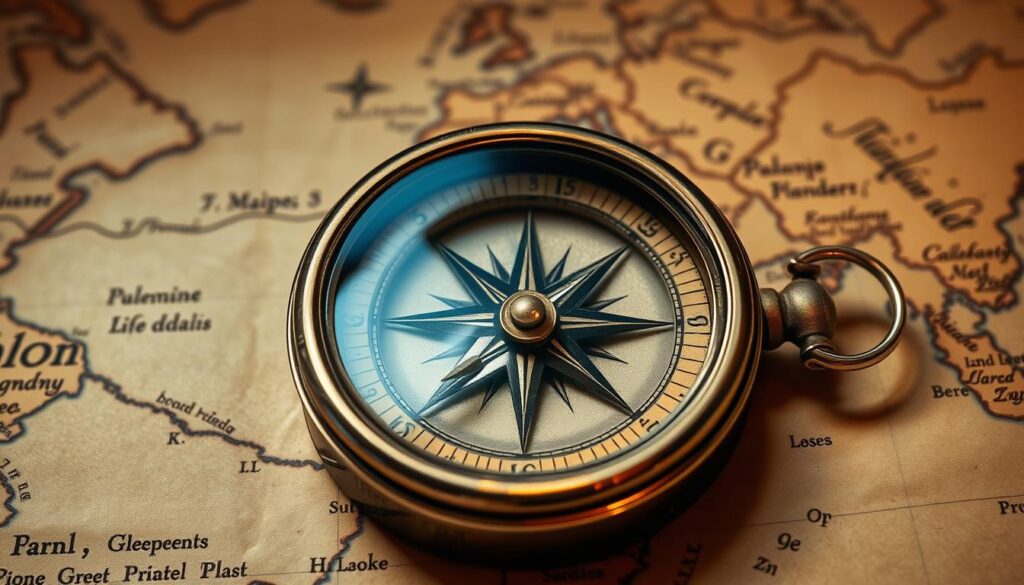Thinking back to my time outdoors, I realize how vital a good water purification system is. In survival situations, clean drinking water can mean life or death. A portable water filtration system can truly be a lifesaver.
My search for the top survival water filter taught me a lot. It’s not just about the filter type. You also need to think about maintenance and how well it works. This guide will help you pick the right survival water filter for your needs.
Key Takeaways
- Understand the importance of having a reliable water purification system in survival situations.
- Learn about the different types of survival water filters available.
- Discover key features to consider when selecting a survival water filter.
- Understand how to maintain and effectively use a water filtration system.
- Make an informed decision when choosing a survival water filter.
Understanding the Importance of Water Filtration
In survival situations, clean drinking water is key to staying alive. When you’re in the wilderness or facing an emergency, finding safe water is hard. So, knowing how to filter water is vital for survival.
Clean water is essential for survival because it affects your health and ability to handle emergencies. Without it, you risk getting sick from waterborne diseases. Water filtration makes sure the water is safe to drink, lowering health risks.
Why Clean Water is Vital for Survival
Clean water keeps you healthy, energized, and sharp, all important in survival. Dehydration can make you less alert and weaker, making survival harder. Also, having clean water boosts your mood and sense of safety, which is psychologically beneficial in tough times.
Common Sources of Contaminated Water
Common sources of contaminated water include:
- Streams and rivers that may contain animal or human waste
- Lakes and ponds that can be contaminated by agricultural runoff or industrial waste
- Standing water or stagnant pools that can harbor bacteria and other pathogens
These places can have harmful pathogens like giardia and cryptosporidium. These can cause stomach problems.
Health Risks of Drinking Unsafe Water
Drinking unsafe water can cause many health problems, from mild stomach issues to serious diseases. Waterborne pathogens can lead to:
- Gastroenteritis, which can cause severe dehydration
- Dysentery, a condition with bloody diarrhea
- Severe diseases like cholera or typhoid fever in some cases
The health risks of drinking contaminated water show why having a good emergency water filter or outdoor water purifier is so important. Knowing these risks helps us see why we need to filter water well.
Types of Survival Water Filters Available
Survival situations need reliable water filters. Knowing the different types is key. The right water filter can be a lifesaver when venturing into the wilderness or preparing for emergencies.
Gravity Filters: Pros and Cons
Gravity filters, like the Waterdrop Gravity filter, are efficient and easy to use. They pull water through the filter using gravity. This makes them great for groups or when filtering a lot of water.
They have high output and are easy to use. But, they can be bigger and less portable than other options.
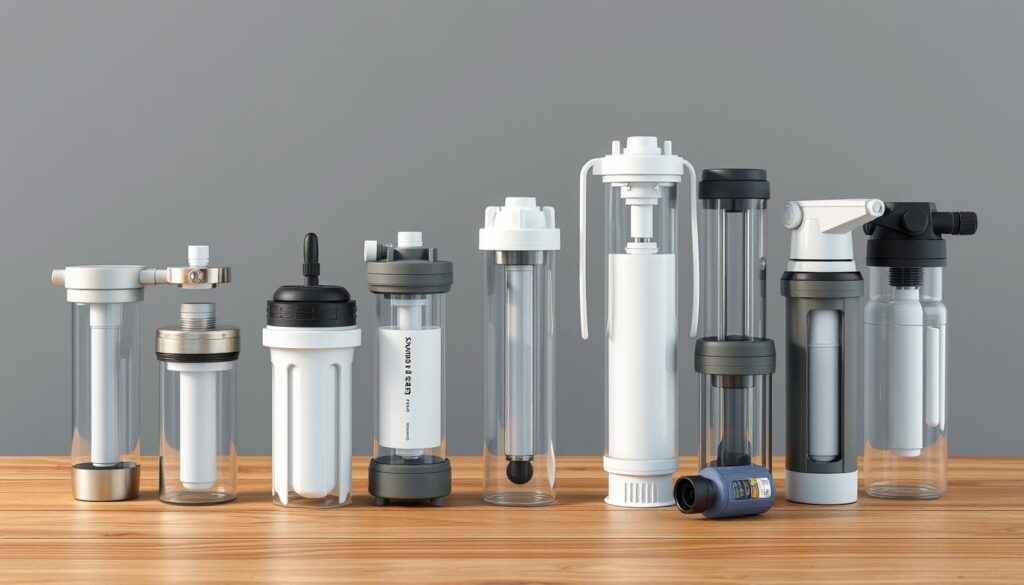
Pump Filters: Efficient but Labor-Intensive
Pump filters, like the MSR Guardian Purifier, filter water well but need manual effort. They filter fast and remove many contaminants. But, they can be tiring to use, which might not be good in all situations.
Straw Filters: Lightweight and Portable
Straw filters, such as the Sawyer Mini, are made for individual use. They are light and easy to carry on trips or in emergency kits. They might not filter as much water as others, but they are easy to use and convenient.
UV Purifiers: Technology Behind the Disinfection
UV purifiers use ultraviolet light to kill bacteria and viruses. They add extra protection against harmful microorganisms. They don’t remove solid particles like traditional filters do, but they are great at killing pathogens.
Choosing the right survival water filter depends on your needs. Consider the environment, the number of people, and your preferences for ease of use and maintenance.
Key Features to Consider in a Survival Water Filter
When you’re in the wilderness or facing emergencies, clean water is key. A survival water filter can be a lifesaver. But with so many choices, knowing what to look for is vital. Here, I’ll cover the main things to think about when picking a survival water filter.
Filtration Speed and Output Volume
The speed and volume of a water filter matter a lot. A fast filter is important in survival situations where time is critical. A filter that can handle a lot of water is great for groups or big water needs. Look for a filter that can move at least 1 liter per minute.
Filter Lifespan and Replacement Options
The filter’s lifespan and replacement options are key. A long-lasting filter means less frequent replacements, which is handy for long trips. Also, think about the cost and availability of new filters. Filters with replaceable parts or easy cleaning can save money over time.
Size and Weight for Portability
For those who love the outdoors or backpacking, a filter’s size and weight are big deals. A light and small filter is easier to carry, perfect for long walks or evacuations. Look for filters under 1 pound and small enough to fit in your backpack.
Ease of Use in Emergencies
In emergencies, a filter that’s easy to use can be a lifesaver. Choose a filter that’s simple, even for those with little training. Opt for filters with clear designs and low maintenance. For example, gravity-fed or straw filters are easy to use and don’t need much skill.
For more on portable water filters and their benefits, check out this resource. It’s a detailed guide on keeping safe drinking water with you wherever you go.
Comparing Popular Survival Water Filter Brands
When looking for reliable survival water filters, names like Katadyn, Sawyer, LifeStraw, and Berkey stand out. These brands are known for their quality, effectiveness, and making users happy.
Katadyn: Trusted for Decades
Katadyn has been a leader in water filtration for decades. They offer filters for personal use and for groups. For example, the Katadyn Hiker Microfilter is a favorite among outdoor lovers.
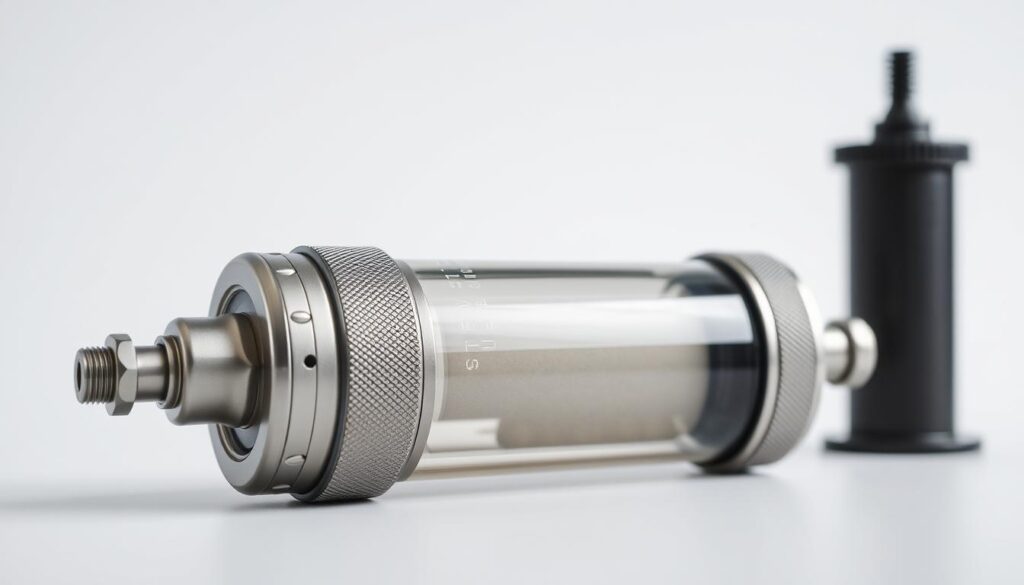
Sawyer: Compact and Versatile
Sawyer is famous for its small and versatile water filters. They are perfect for backpackers and survivalists who need something portable. Their filters are light, easy to use, and effective.
LifeStraw: Designed for Individual Use
LifeStraw is known for its personal water filters. They are affordable and effective, making clean drinking water available to more people.
Berkey: Reliable for Larger Groups
Berkey water filters are great for families or groups. They can filter a lot of water and are known for their effectiveness in removing contaminants.
Assessing Your Unique Survival Needs
Understanding your survival needs is key to staying alive. Knowing what you need helps pick the right water filter.
Solo vs Group Survival Situations
First, think about if you’ll be alone or with others. Solo survival situations need a light, easy-to-carry water filter. This is because you have to carry everything yourself.
Groups, on the other hand, need a filter that can handle more water. This is because everyone needs clean water.
Type of Environment: Urban vs Wilderness
The place you’ll be surviving in matters a lot. Urban survival means dealing with things like heavy metals and industrial waste. Wilderness survival is about removing bacteria and viruses from water.
Knowing what you’ll face helps pick the right filter. It’s all about matching the filter to the environment.
Duration of Setup: Short Trips vs Long-Term Survival
How long you’ll be surviving also matters. For short trips, a simple, small filter is enough. It just needs to be easy to use.
But for long-term survival, you need something more. A filter that lasts longer or can be replaced is key. This ensures you always have clean water.
By thinking about these things, you can choose the best water filter for your survival needs.
Costs Involved in Purchasing a Survival Water Filter
Survival water filters vary in price, from affordable to high-end. The price depends on the technology, how long the filter lasts, and the brand’s reputation.
Budget Options: Affordable Yet Reliable Filters
For those on a tight budget, there are reliable survival water filters. The Membrane Solutions Straw is a great example. It filters water well but is easy on the wallet. These filters are perfect for those who need basic purification without spending a lot.
When looking at budget options, remember to weigh cost against performance. Cheaper filters might save money but might not protect as well as pricier ones.
Mid-Range Value: Balanced Performance and Price
Mid-range survival water filters offer a good balance. Brands like Katadyn and Sawyer make filters that are both effective and affordable. They often have longer lifespans and can filter more water, making them great for many users.
| Brand | Model | Price Range | Filter Lifespan |
|---|---|---|---|
| Katadyn | Hiker Microdrip | $50-$70 | 1000 liters |
| Sawyer | Mini Water Filtration System | $20-$40 | 100,000 gallons |
High-End Choices: Advanced Features for Serious Survivalists
For serious survivalists or those needing top-notch water purification, high-end filters are available. The ITEHIL Powered RO is a top choice with advanced technology like reverse osmosis. These filters are pricier but offer better safety and peace of mind.
“Investing in a high-quality survival water filter is not just about the cost; it’s about ensuring access to clean drinking water when it matters most.”
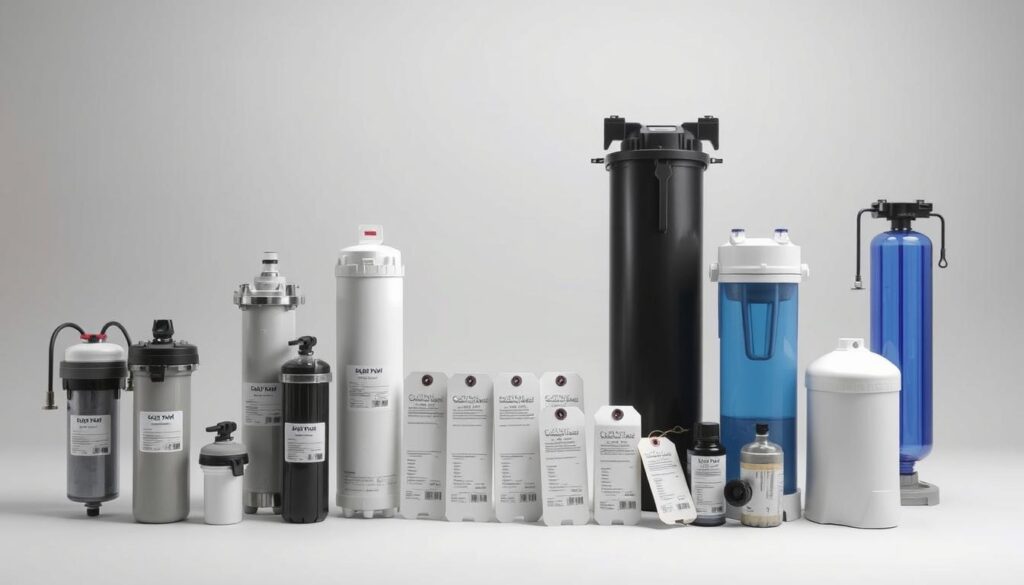
When picking a survival water filter, think about the cost over time. Consider the cost of replacing filters and any maintenance needs.
Maintenance Tips for Survival Water Filters
Keeping your survival water filter in good shape is key. Regular care makes sure it works well and keeps your water clean. A well-kept filter is a trusted friend in tough times.
To keep your filter in top shape, know what it needs. For example, Katadyn filters need cleaning to avoid clogs.
Regular Cleaning Practices
Cleaning your filter often is a must. Backflushing, which reverses water flow, helps remove particles. Sawyer filters suggest backflushing after each use to keep flow rates high.
Different filters need different cleaning methods. Some gravity-fed filters need sediment cleaning, while straw filters just need a quick rinse.
Proper Storage Techniques
Storing your filter right is important to avoid damage and contamination. Keep it in a dry, cool spot, away from sunlight. LifeStraw filters should be dried before storage to stop bacteria growth.
Also, use a protective case to prevent physical harm. Berkey filters come with a lid to keep them clean when not in use.
| Filter Brand | Cleaning Method | Storage Recommendation |
|---|---|---|
| Katadyn | Backflushing | Dry, cool place |
| Sawyer | Backflushing | Dry, protected from dust |
| LifeStraw | Rinsing | Dry, cool place |
| Berkey | Cleaning with soap and water | With lid closed |
Recognizing When to Replace Filters
Knowing when to replace your filter is just as important as maintaining it. Filters have a lifespan, like Sawyer’s 2000 liters. Look for signs like slower water flow or harder pushing to know it’s time for a new one.
In summary, keeping your survival water filter in good condition requires regular cleaning, proper storage, and knowing when to replace it. By following these tips, your filter will be ready when you need it most.
Testing Your Survival Water Filter
Knowing how to test your survival water filter is key to safe drinking water. When you’re in the wilderness or facing a survival situation, clean water is essential. So, it’s important to make sure your water filter works right.
Understanding the Testing Process
Testing a survival water filter means checking if it removes contaminants and particles from water. You need to know what it can filter out, like bacteria, viruses, and heavy metals. It’s also important to follow the testing methods suggested by the maker.
Interpreting Filter Performance Data
After testing, it’s important to understand the data from your survival water filter. Look at how well it filters out contaminants, its flow rate, and how much water it can handle. For example, if it says it removes 99.99% of bacteria, you need to know what that means for your water’s safety.
Key performance indicators include:
- Contaminant removal efficiency
- Flow rate (liters per minute)
- Filter lifespan (total liters filtered)
Real-Life Endurance Tests
Endurance tests really test your survival water filter. They mimic the challenges it might face in a survival situation. You can test it with water from rivers, lakes, or ponds and see how it holds up over time. It’s also good to test it in different conditions, like different water temperatures and how clear the water is.
By understanding the testing process, interpreting performance data, and conducting real-life endurance tests, you can confidently rely on your survival water filter to provide safe drinking water when it matters most.
User Reviews and Recommendations
User reviews give real insights into survival water filters’ performance. They show how these filters work in different situations. This helps buyers make better choices.
Gathering Testimonials of Different Filters
Reviews of various survival water filters show their good and bad points. For example, gravity filters are easy to use and work well. But pump filters are efficient but hard to use.
Many users like the Katadyn Hiker Micro for its toughness. Others prefer the LifeStraw Personal Water Filter for being easy to carry. These opinions help understand how filters do in real life.
Professional Reviews from Outdoor Experts
Outdoor experts and survivalists also review survival water filters. They test these filters under tough conditions. Their opinions are very helpful in knowing what filters can do.
Experts say the Sawyer Mini is great because it’s small but versatile. They also like the Berkey Water Filter for handling lots of water. Their support proves these filters work well.
Key Takeaways from User Experiences
Reviews highlight the need to think about filter life, how easy it is to use, and upkeep. Users say a good filter should be simple to use, maintain, and replace.
- Filter lifespan and replacement options are key for long-term use.
- How easy it is to use matters a lot, even in emergencies.
- How much upkeep a filter needs affects how happy users are.
In summary, user reviews and advice are vital for anyone buying a survival water filter. They share real experiences with different filters’ performance, durability, and use. This helps buyers make smart choices.
Conclusion: Making an Informed Decision
As we wrap up our look at survival water filters, it’s key to remember what matters most. The right filter can save your life by providing clean drinking water. My top picks strike a balance between performance, reliability, and cost, meeting different needs.
Keeping water safe is a must for survival, and a good filter is essential. By looking at the filter type, key features, and upkeep, you can pick the best one for you. This ensures you’re ready for any survival situation.
Recap of Essential Considerations
When choosing a filter, think about the filter type, how fast it works, how long it lasts, and what it removes. Knowing these details helps you find a filter that fits your survival needs perfectly.
My Top Picks for Survival Water Filters
After reviewing, my top picks are from trusted brands like Katadyn, Sawyer, and LifeStraw. These filters are reliable, perform well, and are good value for money.
Final Thoughts on Water Safety
In summary, having clean drinking water is key to survival. By choosing a dependable water filter and learning how to use it, you can stay safe in any survival situation.
FAQ
What is the primary purpose of a survival water filter?
A survival water filter’s main job is to clean water. It removes harmful stuff like bacteria and viruses. This makes the water safe to drink and helps prevent sickness.
What are the most common sources of contaminated water?
Water from streams, rivers, and lakes can be dirty. This is because they might have animal or human waste. Drinking from these places can be risky for your health.
What types of survival water filters are available?
There are many kinds of survival water filters. You can find gravity filters, pump filters, straw filters, and UV purifiers. Each has its own good points and bad points.
How do I choose the right survival water filter for my needs?
To pick the right filter, think about how fast it filters water and how long it lasts. Also, consider its size, weight, and how easy it is to use. Think about your survival needs, like if you’re alone or with others, and the environment you’ll be in.
What are some popular brands of survival water filters?
Well-known brands include Katadyn, Sawyer, LifeStraw, and Berkey. They’re known for being reliable, effective, and versatile. They work well in different survival situations.
How much do survival water filters typically cost?
Survival water filters can cost a lot or a little. You can find affordable options like the Membrane Solutions Straw. Or, you can get high-end models with extra features, like the ITEHIL Powered RO.
How do I maintain my survival water filter?
To keep your filter in good shape, clean it regularly. This means backflushing and storing it right. Also, know when it’s time to replace it to keep it working well.
How do I test my survival water filter?
Testing your filter means understanding how to do it. You need to look at how well it filters and test it in real situations. This ensures it works as it should.
What are some key considerations for portable water filtration systems in emergency situations?
When choosing a portable filter for emergencies, think about how easy it is to use. Also, consider how fast it filters and how much water it can handle. Don’t forget about its size, weight, and how long it lasts.
Can a survival water filter be used for backpacking or camping?
Yes, many survival water filters are made to be light and easy to carry. This makes them perfect for backpacking, camping, or other outdoor adventures.
How do I know when to replace my survival water filter?
To know when to replace your filter, watch how it performs. Look for signs of wear and follow what the maker says about replacing it.

